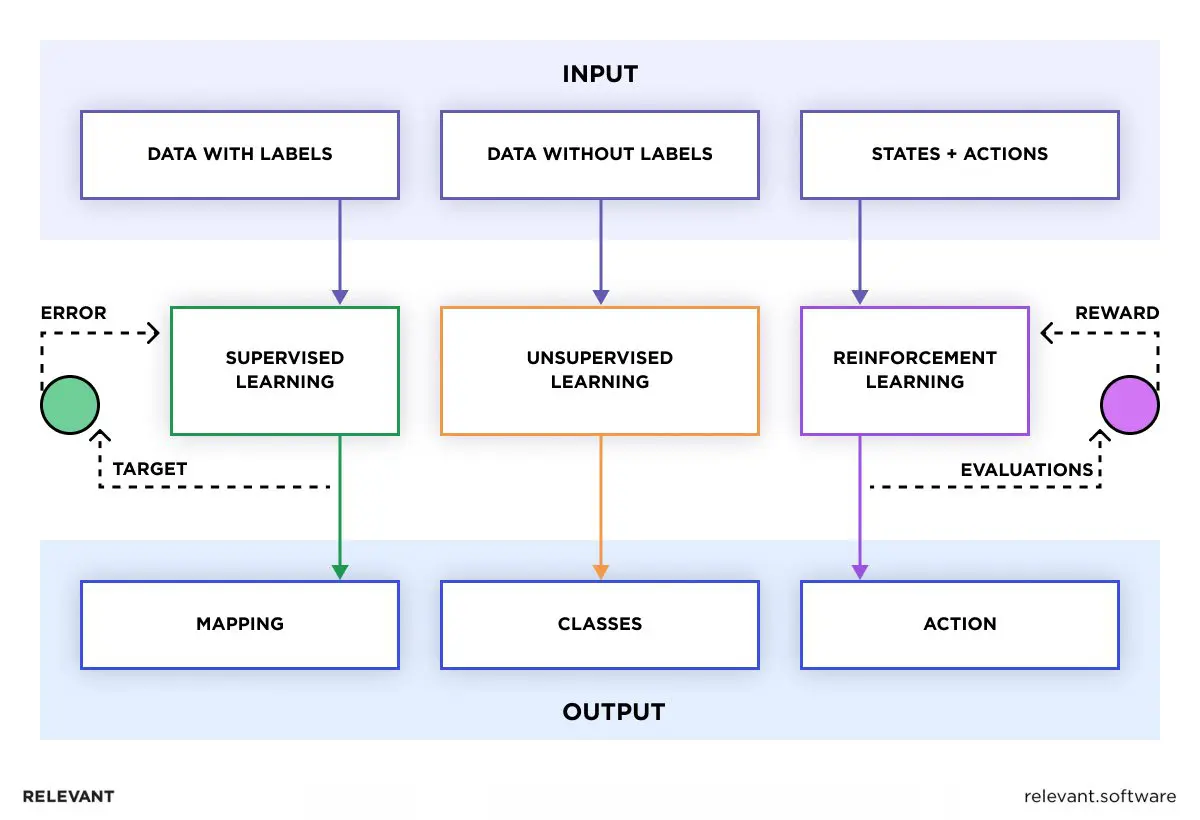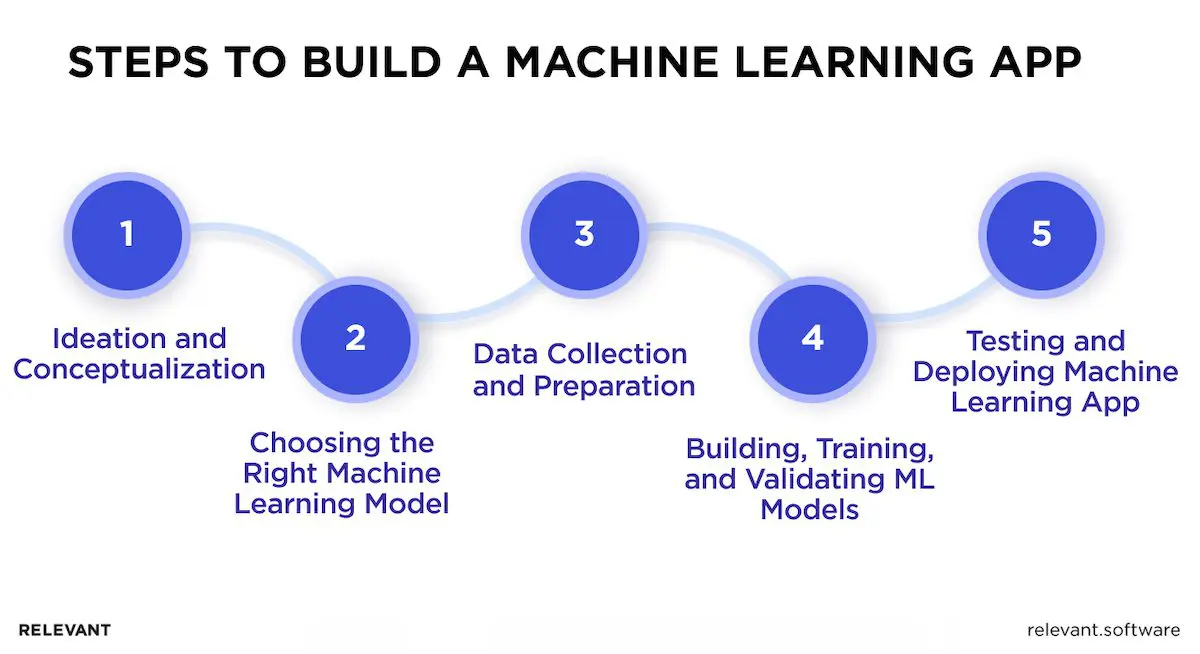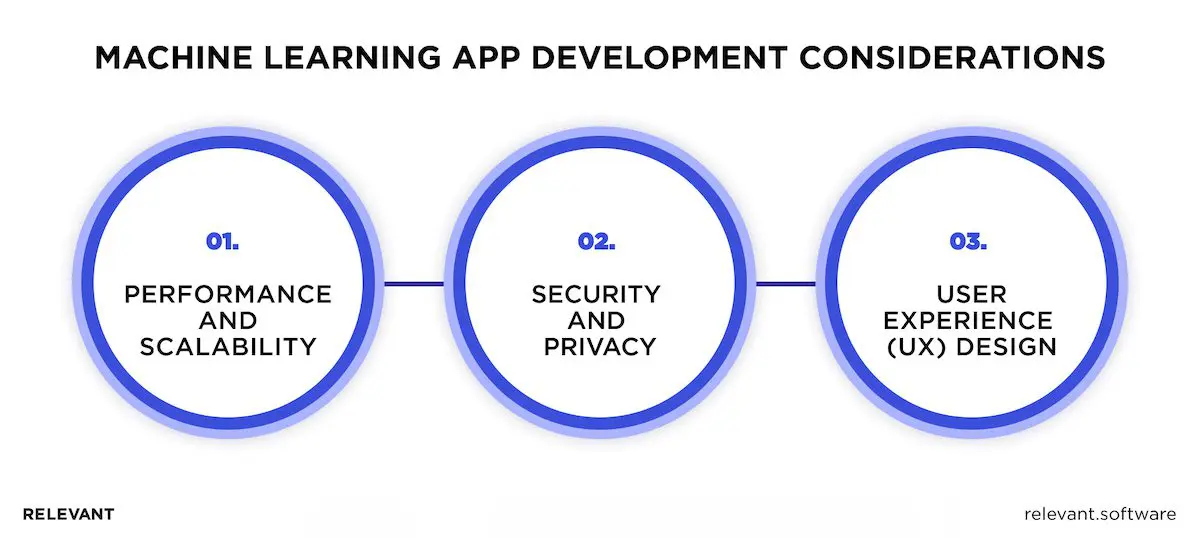Machine Learning App Development: A Professional's View

Have you ever been impressed by how banking apps alert you to unusual account activity or how shopping apps recommend products you’ve been thinking about? Such instances of technology appearing to “read your mind” are the result of machine learning app development. It’s become so widespread you may not even realize an app uses ML. But this is what differentiates a truly pioneering app from an ordinary one.
That’s precisely why no company wants to lag in capturing artificial intelligence opportunities. If you’re in the same boat, this guide from our AI software development experts is designed to assist you.
What is Machine Learning? A Brief Introduction
Machine Learning (ML), a branch within the broader domain of artificial intelligence, equips machines with the capability to assimilate knowledge directly from data, bypassing the need for direct programming. Once trained, these ML models gain the capability to forecast results or classify unfamiliar datasets they encounter.
When a machine learning system processes new data, it predicts outcomes by leveraging patterns it has identified in past data. The accuracy of these predictions closely ties to the volume of data used to train the model; essentially, the more data you have, the more precise your model can be.

Machine Learning’s Key Components
At the heart of machine learning, there are crucial components that empower these systems to evolve and enhance their capabilities progressively. Let’s take a closer look at these key elements:
| Component | Description |
| Data | Essential for learning and decision-making, data must be vast and diverse. Its quality and volume are critical for model accuracy. |
| Model | Links input to output, identifying patterns. Models are trained, tested, and then applied to predict or make decisions. |
| Algorithm | Powers the model’s learning, using data to predict outcomes and enhance performance. |
Machine learning methods are broadly classified into three main types, each with its unique approach and application:
Supervised Learning
In this approach, algorithms learn from a labeled dataset where each input is matched with the right output. Supervised learning is pivotal for tasks that require clear categorization (classification) or prediction of numerical values (regression). For instance, in a health app, supervised learning can predict patient health risks based on historical health data. The method’s success heavily depends on the quality and amount of labeled data.
Unsupervised Learning
Unsupervised learning deals with unlabeled data, searching for patterns and structures without a clear guide. It’s great for discovering data insights, grouping similar points (clustering), and simplifying data to grasp its structure (dimensionality reduction). For example, an e-commerce ML app can cluster customers with similar purchasing behaviors without predefined categories, enabling personalized marketing strategies. However interpreting the results can be tough since there’s no straightforward answer key, requiring deeper analysis to ensure accuracy.
Reinforcement Learning
This type focuses on learning optimal actions through trial and error to achieve a specific goal. It involves an agent that makes decisions, a set of possible states, actions per state, and rewards or penalties as feedback for the actions taken. This learning process is dynamic and continually adjusts based on the feedback received to maximize the reward over time. Reinforcement learning is successfully used for scenarios like autonomous driving, where it makes decisions based on a changing environment, but crafting effective reward systems is still a challenge.

Your next read – How is the Future of Machine Learning Shaping Up?
Machine Learning in App Development
Machine learning app development services mean building systems that can handle huge data sets, learn to spot patterns and make smarter decisions over time. It overtures basic apps to intuitive systems that resonate with user behaviors. That’s the impact ML makes:
User Experience Enhancement
Machine learning’s ability to process and learn from vast amounts of user interaction data enables a level of personalization previously unattainable. Beyond merely suggesting content, ML algorithms can adjust app interfaces, functionalities, and interactions to match user preferences, even predicting needs before the user explicitly expresses them. According to a McKinsey&Company report, personalization powered by machine learning can increase customer satisfaction by up to 75%.
Boosted Security
In security, ML’s power to sift through user behaviors and detect patterns enables it to uncover potential fraud or breaches early on, ensuring proactive protection for users. Financial apps, for example, use ML to flag unusual transactions, minimizing the risk of fraud. A report by IBM Security mentions that businesses leveraging machine learning for security automation have seen a 20% improvement in threat detection efficiency.
Operational Efficiency
With ML, every swipe, click, and interaction within your app is a data point. Analyzing these can reveal trends that inform smarter decisions for future app development and marketing strategies. Research by Accenture says that organizations that implement AI across their operations can achieve a 40% increase in productivity.
Increased Accessibility
The ML subfield – Natural Language Processing, makes applications more accessible to a broader audience. Chatbots and voice assistants powered by NLP can understand and respond to human speech naturally, breaking down barriers for users with visual impairments or those who find traditional navigation challenging. An MIT Technology Review study highlights that AI captioning and translation tools are making content more accessible for the deaf or hard of hearing, expecting an 8.9% market growth by 2028.
Overall, machine learning app development offers a large pool of advantages – and these are not just surface improvements. These novelties really hold great potential, and businesses that implement them will find themselves ahead of the curve shortly.
Machine Learning App Development: The Process
Let’s bypass the usual steps of app development—design, coding, testing, and maintenance—that apply to all apps. In our guide to creating an ML-powered app, we focus squarely on the ML aspects.

Ideation and Conceptualization
The first step is recognizing problems that ML can solve more efficiently than traditional methods (to prevent its use in projects where it isn’t needed). Commonly, this includes areas where automation, thorough data analysis, and pattern recognition could significantly uplift user experiences or meet distinct needs efficiently.
Initial steps should include extensive market research to familiarize yourself with existing solutions, determine your target market, and measure the demand for your machine learning application. This groundwork makes sure your app is positioned uniquely and fulfills an authentic demand.
Choosing the Right Machine Learning Model
Different problems require different ML models. Selection criteria should include the nature of the data (e.g., images, text), the goal (e.g., prediction, classification), and available computational resources. This phase aligns the app’s objectives with the most effective ML model. For instance, a classification model might be suitable for spam detection, while a recommender system would benefit from a collaborative filtering approach.
Data Collection and Preparation
This phase emphasizes collecting high-quality, relevant data and preparing it through cleaning, formatting, and transformation to train your model effectively. For data gathering, options range from scraping information off the web to employing publicly shared datasets.
“Garbage in, garbage out” from George Fuechsel applies here – the quality and quantity of your data directly impact the effectiveness of your model. The preparation process ensures the data is in a format that the chosen ML model can process, involving steps like normalization, handling missing values, and feature extraction.
Building, Training, and Validating ML Models
This involves feeding the prepared data into the model and adjusting its parameters to improve its predictions, striking the right balance between precision and processing speed. After training, the model must be evaluated using metrics like accuracy, precision, recall, and the F1 score. This assessment helps ensure that the model performs well on unseen data and meets the application’s objectives.
Testing and Deploying Your Machine Learning App
ML apps must undergo rigorous testing to validate their functionality, usability, and accuracy. Testing frameworks ought to be adapted to address the particular challenges introduced by ML components, securing their consistent functionality under varied circumstances.
The deployment phase involves making your ML app available to users. Whether deploying to a cloud platform or on-premise servers, considerations include scalability, security, and ensuring the app can respond in real-time as needed. Following the app’s rollout, continuous performance checks are key. Because data patterns shift over time, it’s vital to keep the model current by periodically updating and retraining it with the latest data.
Understanding and navigating through these stages with careful planning and execution enables the development of successful ML applications that meet users’ needs and stand out in the competitive market.
Related: How to Make a Chatbot
Key Considerations in Machine Learning App Development
Crafting a successful machine learning (ML) app requires careful consideration beyond just the technical aspects of model development. Here, we delve into some crucial areas of machine learning app development that demand an expert’s touch:

Performance and Scalability
Suppose your app gained immense popularity—but can it handle the surge in data and users? This is where performance becomes paramount. You’ll need strategies to ensure your ML models can process information swiftly and deliver results efficiently even as the data volume and user base expand. This might involve techniques like model compression or distributed computing.
Scalability goes hand-in-hand with performance. Your app’s architecture should be designed to seamlessly adapt to increasing demands. This could involve using cloud-based infrastructure that allows you to add resources dynamically.
Security and Privacy
Utilizing machine learning effectively involves a serious commitment to user privacy and data security. Its protection includes robust encryption techniques, secure data storage, and clear communication with users around data collection practices.
In this process, one should not forget about compliance with data privacy regulations like GDPR (General Data Protection Regulation) and CCPA (California Consumer Privacy Act. Understanding these regulations and building your app with compliance in mind is essential.
User Experience (UX) Design
Integrating powerful ML features shouldn’t come at the cost of a clunky interface – an app must be intuitive and user-friendly. In feature engineering for machine learning, we recommend prioritizing clear user interactions and effective data visualization to empower users to understand and interact with the ML aspects of the app.
Tools and Technologies for Machine Learning App Development
Choosing the right machine learning tool from the vast and constantly updating options can feel like finding a needle in a haystack. We’ll spotlight the best of them in the machine-learning universe to make picking the right one a bit easier for you.
Machine Learning Frameworks and Libraries
Selecting the appropriate framework or library is critical for machine learning app creation. TensorFlow, for example, offers versatility and broad support, suitable for various projects, while PyTorch provides ease and a dynamic graph for simpler debugging. The decision, be it TensorFlow, PyTorch, Caffe, Scikitor, or a beginner option like Keras, hinges on project requirements, machine learning app development company team skill level, and specific needs.
Development Platforms and Languages
Success in machine learning app development relies not only on frameworks but also on the right programming languages and platforms. At the top is Python with its simplicity and rich library ecosystem. This language pairs well with any AI/ML library, like NLTK or Scikit-learn. For mobile application development, Android Studio and Xcode are popular, while cross-platform tools like Flutter and React Native allow for single-code-based deployment on both Android and iOS, saving time and resources.
The quickest way to build an ML app for smartphones is to use established ML services such as Google’s ML Kit, Firebase ML, or Apple’s Core ML. Besides, developers must decide between cloud-based ML functions or edge computing for on-device ML processing.

Build an ML App with Relevant Software
We could tell you more, but it’s yet evident that creating machine learning-powered apps isn’t simple; it needs deep expertise in data science and algorithms. That’s where partnering with a machine learning app development company like Relevant really pays off.
In addition to app developers, designers, and QA engineers, we bring on board data analysts (or data scientists) – experts focused on handling data and crafting ML models. They tackle all the technical bits and make sure your ML app does what it’s supposed to do for your business, setting you apart from the competition.
Ready to advance your app with ML technology? Contact our machine learning app development company to start!



